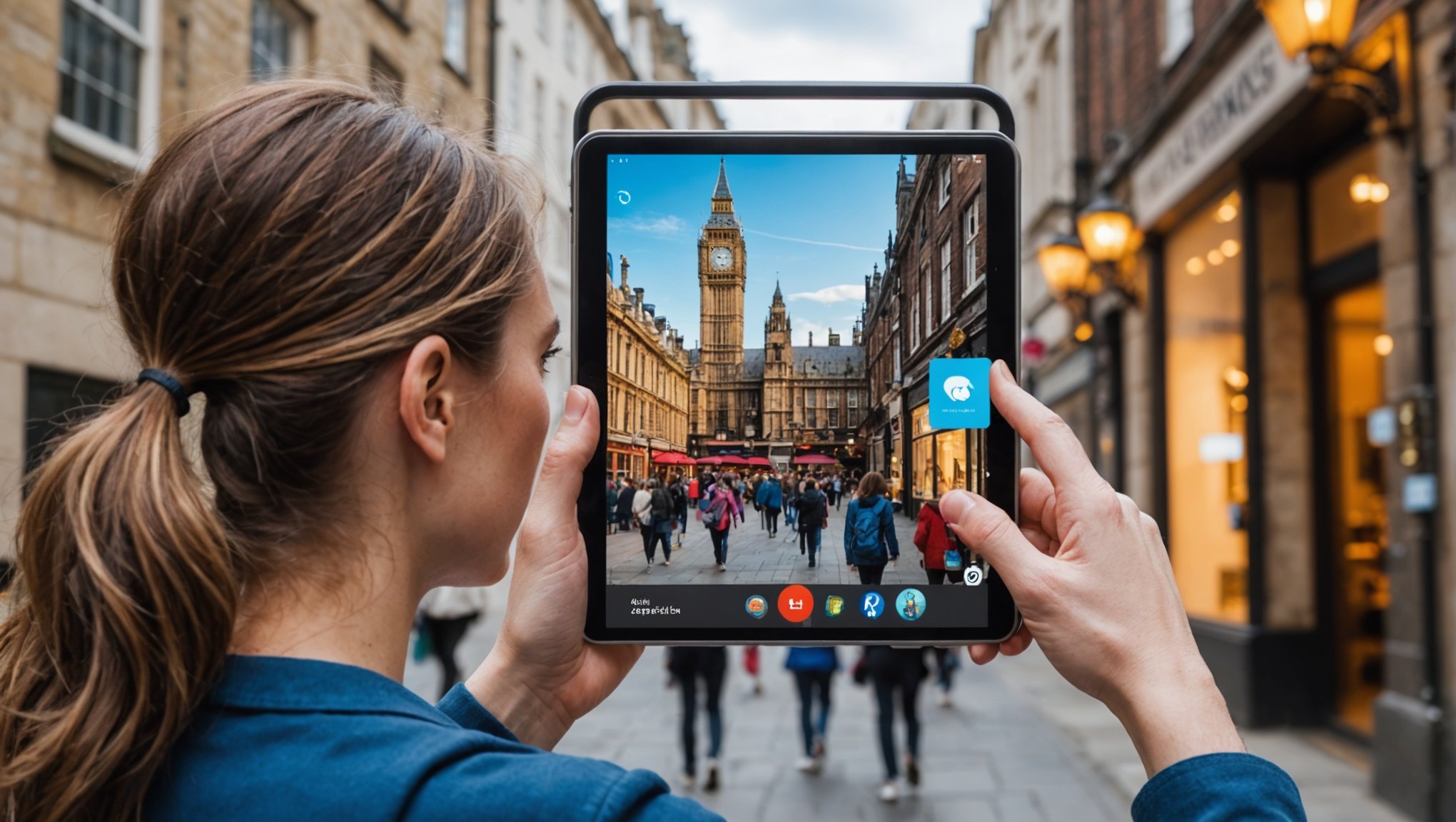Transforming Visitor Experiences: The Role of Augmented Reality in Elevating UK Tourist Attractions
In the ever-evolving landscape of tourism, technological innovations are revolutionizing the way we experience and interact with tourist attractions. One of the most significant advancements in this field is the integration of augmented reality (AR) and virtual reality (VR) into various tourist destinations, particularly in the UK. This article delves into how AR is transforming visitor experiences, making them more immersive, interactive, and memorable.
The Rise of Augmented Reality in Tourism
Augmented reality is no longer a futuristic concept but a tangible tool that is being widely adopted in the tourism industry. By overlaying digital information on the real world, AR enhances the visitor experience, providing a richer and more engaging interaction with historical sites, museums, and other attractions.
Also to see : Top Strategies for UK Event Planners to Seamlessly Blend Virtual and Hybrid Experiences
Applications of AR in UK Museums
UK museums are at the forefront of this technological shift. Institutions like the British Museum, Science Museum, and Natural History Museum in London are pioneering the use of AR to create family-friendly and immersive environments. For instance, the Science Museum offers AR exhibits that allow children to visualize scientific phenomena and historical events directly from their devices. This not only enriches their understanding but also makes learning accessible and enjoyable.
Here are some key ways AR is being used in UK museums:
Also to see : Creative Tactics for UK Hotels to Boost Guest Loyalty: Unlocking Innovative Strategies
- Interactive Exhibits: AR enables visitors to step into history and interact with exhibits in unprecedented ways. For example, the Natural History Museum offers AR experiences that bring ancient creatures to life, allowing children to dig for fossils and interact with life-size dinosaur models.
- Virtual Reconstructions: AR can reconstruct historical sites and events, providing visitors with a glimpse into the past. The Smithsonian in Washington, D.C., and similar institutions in the UK use AR to show how ancient civilizations built their cities and how historical events unfolded.
- Mixed Reality Experiences: The integration of AR with real-world artifacts creates a mixed reality experience that is both educational and captivating. The “Loot: 10 Stories” exhibition, which has been held at the Mauritshuis and the Humboldt Forum, uses VR and AR to delve into the complex history of looted objects, offering a visceral and simultaneous experience of past and present.
Enhancing Cultural Heritage Sites
AR is not limited to museums; it is also transforming the way we experience cultural heritage sites across the UK.
Real-Time Information and Navigation
AR technology can provide real-time information about historical sites, enhancing the visitor experience. Here are a few examples:
- Historical Site Reconstructions: Standing in front of a historical site like the Roman Colosseum, visitors can use AR to see how it looked in its prime. This technology is being used in places like Pompeii and the Forum of Augustus in Rome to bring history to life.
- Interactive Tours: AR tours can overlay digital information on physical sites, offering interactive and educational content. This enhances real-world tours with added layers of history, visuals, or entertainment. For instance, AR translation apps like Google Lens help travelers navigate foreign text, such as street signs or menus, making it easier to connect with local cultures.
Improving Visitor Engagement
One of the primary goals of integrating AR into tourist attractions is to improve visitor engagement.
Immersive and Interactive Experiences
AR creates immersive and interactive experiences that capture the interest of visitors and encourage them to explore more. Here are some ways AR is achieving this:
- Hands-On Activities: Museums are designing exhibits that cater to the interests and developmental stages of children. For example, the Natural History Museum offers activities like digging for fossils and interacting with life-size dinosaur models, making history tangible and exciting.
- Virtual and Augmented Reality Tours: Virtual tours allow travelers to explore destinations before they arrive, influencing their travel decisions and improving their overall travel experience. AR can also provide cultural experiences, such as virtual cultural festivals or traditional performances, fostering a deeper connection to the destination.
Practical Benefits for Tourism
The integration of AR into tourism offers several practical benefits for both visitors and the tourism industry.
Enhanced Decision-Making and Accessibility
Here are some of the key benefits:
- Enhanced Decision-Making: AR provides virtual previews of destinations and accommodations, helping travelers make more informed decisions. This leads to higher satisfaction rates with their choices.
- Accessibility for All: AR can make travel experiences accessible to individuals who may have physical limitations or financial constraints. Virtual travel allows people to explore the world from the comfort of their homes, reducing the need for physical travel and its associated costs.
- Sustainable Travel: AR supports sustainable travel by reducing the need for paper maps and brochures. Instead, travelers can access all necessary information digitally, contributing to a more environmentally friendly travel experience.
Future Potential and Challenges
As AR technology continues to evolve, it holds exciting possibilities for the future of tourism.
Integration with Other Technologies
Here are some potential developments:
- Integration with Virtual Reality: The convergence of AR with VR can create hybrid experiences that blend virtual and real-world elements, enhancing the travel experience for users. For example, the “Loot: 10 Stories” exhibition combines VR and AR to provide a comprehensive and immersive experience.
- Improved Personalization: Future AR experiences can become more personalized, allowing users to tailor virtual tours and activities based on their preferences and interests. This could be achieved through advanced data analytics and user profiling.
- Broader Adoption: As more tourism businesses recognize the benefits of AR, we can expect wider adoption across various sectors, from travel agencies to attractions and accommodations. This broader adoption will further enhance the accessibility and impact of AR in tourism.
Case Studies and Examples
To illustrate the impact of AR in tourism, let’s look at some specific case studies and examples.
Snap Street: An Immersive AR Experience
Snapchat’s launch of Snap Street in East London is a prime example of how AR can transform retail and tourist experiences. This immersive high street experience features shop-fronts showing off AR experiences curated by brands like Depop, Boots, and Cosmopolitan. Visitors can engage in various activities, such as using the Snapchat x Depop AR Mirror or trying out new makeup looks using AR at the Snapchat x Boots vanity mirrors.
The Museums in the Metaverse Project
The Museums in the Metaverse project at the University of Glasgow is developing a prototype digital platform that will host hundreds of 3D models of artifacts scanned from Scottish museum collections. This platform will allow users to manipulate and handle historic objects within virtual environments, providing an immersive VR experience that goes beyond what is possible in a physical museum setting.
Table: Comparing AR and VR in Tourism
Here is a comparative table highlighting the key differences and similarities between AR and VR in the context of tourism:
| Feature | Augmented Reality (AR) | Virtual Reality (VR) |
|---|---|---|
| Definition | Overlays digital information on the real world | Creates a fully immersive digital environment |
| Usage | Used in museums, historical sites, and cultural events | Used in virtual tours, travel planning, and immersive experiences |
| Accessibility | Can be accessed via mobile devices | Requires VR headsets |
| Interactivity | Enhances real-world interactions | Provides a fully virtual experience |
| Examples | AR tours of historical sites, interactive museum exhibits | Virtual tours of destinations, VR experiences in museums |
| Benefits | Enhances decision-making, increases accessibility, supports sustainable travel | Enhances engagement, provides immersive experiences, aids in travel planning |
| Future Potential | Integration with VR, improved personalization, broader adoption | Integration with AR, improved personalization, enhanced sustainability |
Quotes from Industry Experts
Here are some quotes from industry experts that highlight the significance and potential of AR in tourism:
- “AR by its nature can be a lot more accessible and more communal,” says Thanos Kokkiniotis, CEO of the award-winning cultural travel app Smartify.
- “Snap Street will recreate the joy of Snapchat IRL with an experiential shopping destination for our users, their friends and family,” says Ben Wymer, Director of Global Brand Experience at Snapchat.
- “With this history of very unequal relationships and sometimes heartbreaking stories, it’s really important to pull the viewer out of the typical museum context,” says Eline Jongsma, guest curator for the “Loot: 10 Stories” exhibition.
Augmented reality is transforming the way we experience tourist attractions in the UK, making them more immersive, interactive, and memorable. From enhancing cultural heritage sites to improving visitor engagement and providing practical benefits for tourism, AR is set to play a crucial role in the future of travel and tourism.
As technology continues to evolve, we can expect even more innovative applications of AR in the tourism industry. Whether it’s through virtual reconstructions of historical sites, interactive museum exhibits, or immersive retail experiences, AR is redefining the visitor experience and setting new standards for engagement and education.
In the words of Fergus Bruce from the Museums in the Metaverse project, “VR takes the limits off the scale of the exhibition space,” allowing for a more immersive and interactive experience that digital visitors can enjoy from anywhere in the world.
As we move forward, it’s clear that augmented reality will continue to be a key driver in enhancing visitor experiences, making tourism more accessible, engaging, and sustainable for all.











